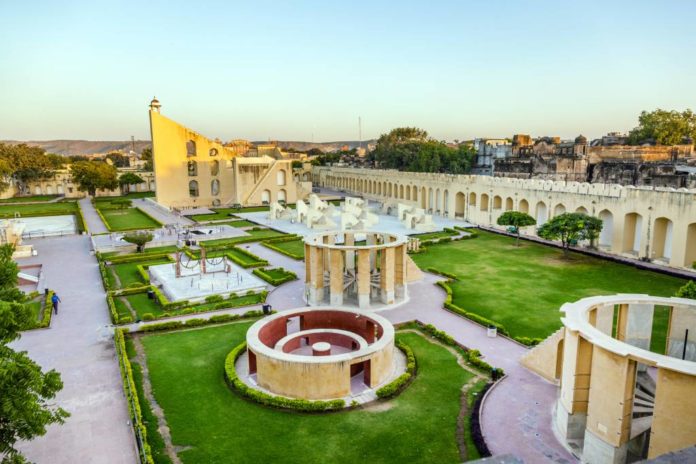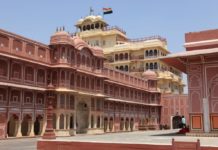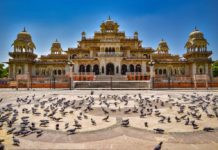The Jantar Mantar of Jaipur is an assortment of 19 architectural edifices of unique geometrical forms that are used to study the astronomical observations through naked eyes. It is a UNESCO World Heritage site that features the world’s largest stone sundial making it a must-add in your itinerary. The word “Jantra Mantra” is derived from Sanskrit language, and it translates to ‘calculating instruments’.
Between 1724 and 1735, Maharaja Sawai Jai Singh II of Jaipur formulated five astronomical observatories in five different cities of north India namely Jaipur, New Delhi, Mathura, Ujjain, and Varanasi which were named “Jantar Mantar”. The Jantar Mantar of Jaipur being the largest and the most equipped of all, attracts various architects, historians, mathematicians and artists from all around the world. It is also the most well maintained of all the other five Jantar Mantar.

The Bewitching Tale of Jantar Mantar and Rectification of Zij Tables
- All the five Jantar Mantar were established by Maharaja Jai Singh II (the founder of Jaipur City) who was a great scholar and a passionate astrologer.
- Due to his proficiency in philosophy, architecture, mathematics, and his tremendous endless knowledge about astronomy, he was commissioned by Emperor Muhammad Shah in the early 1720s to redress the astronomical calculations in Islamic Zij tables and define the calendar precisely.
- To accomplish this, he first amassed all the available astrological data from Europian, Persian and Islamic scripts and examined them.
- After a comprehensive study and research, Maharaja Sawai Jai Singh II formulated geometrical stone structures based on his interpreted data. These stone structures were used as instruments to measure time and determine the position of planetary bodies and were collectively called Jantar Mantar.
- The first Jantar Mantar was built in Delhi in 1724 whereas the Jantar Mantar of Jaipur was built between 1728-1734.
Major Attractions at Jantar Mantar
We’ve mentioned below a few of the significant instruments amongst all the 19 placed at Jantar Mantar, Jaipur. If you desire to understand the working and significance of each instrument in detail, it is advisable to hire a local guide or an audio guide from the entry gate.
- Vrihat Smarat Yantra: Placed at the centre of the Jantar Mantar complex, this 27m tall structure is esteemed as the largest sundial in the world and measures time up to a precision of two seconds. The name “Samrat Yantra” when translated means ‘supreme instrument’.A triangular wall of this instrument is positioned in the North-South direction with a specific angle which is the same as the latitude of this location. The shadow of this triangular wall travels equal distance at equal intervals of time on the Eastern and Western quadrants. This movement is then calibrated to calculate and construe the local time.
- Laghu Samrat Yantra: Popularly known as ‘Small Samrat Yantra’, this instrument is a comparatively smaller sundial than Vrihat Samrat Yantra, and it measures time up to an accuracy of twenty seconds. The triangular ramp of this sundial points towards the North Pole. The shadow movement of this ramp is used to calculate the local time of Jaipur City.
- Digamsa: The Digamsa is a pillar between two concentric outer circles. This instrument helps in predicting the sunrise and sunset time in a day.
- Nadivalaya: This instrument has a pair of circular plates facing North and South which represent the two hemispheres of Earth. These circular plates are inclined at a specific angle so that the instrument is always parallel to Earth’s equatorial plane.
- Ram Yantra: This gigantic tube-like structure is used to determine the elevation and azimuth of the sun and other planets. This instrument can only be found in the Jantar Mantar of Jaipur and Delhi.
How to Get to Jantar Mantar, Jaipur
The Jantar Mantar of Jaipur is fairly easy to locate as it is situated in the heart of the city and near all the major tourist spots like City Palace and Hawa Mahal.
You can book a cab or a private taxi from any part of the city and reach Jantar Mantar. If you want to beat the occasional traffic, opt for a two-wheeler taxi.
Best Time to Visit
As such, the Jantar Mantar complex is open from 9 am to 4:30 pm. Still, it is best to visit the place around mid-day when the sun is vertically above making it easier to understand the working and interpretation of readings of each instrument. It takes anywhere between 60 to 90 minutes to explore the entire Jantar Mantar complex.
Places to Visit Near Jantar Mantar, Jaipur
- City Palace, Jaipur: The City Palace of Jaipur is almost at a 100m distance from the Jantar Mantar complex. One of the most prominent tourist locations in Jaipur, parts of this palace are still used by the royal family for residential purposes. A combination of various museums and art galleries, this place takes you back in time into the Rajputi kingdom.
- Hawa Mahal: The Hawa Mahal is an extension structure to the City Palace complex, built-in 1799 for the royal Rajputi women who strictly followed the ‘Pardha’ system at the time. Also known as ‘Palace of Wind’, the Hawa Mahal is at a 700m distance from Jantar Mantar, and it provides an alluring view of the Jantar Mantar complex from its top floor.










